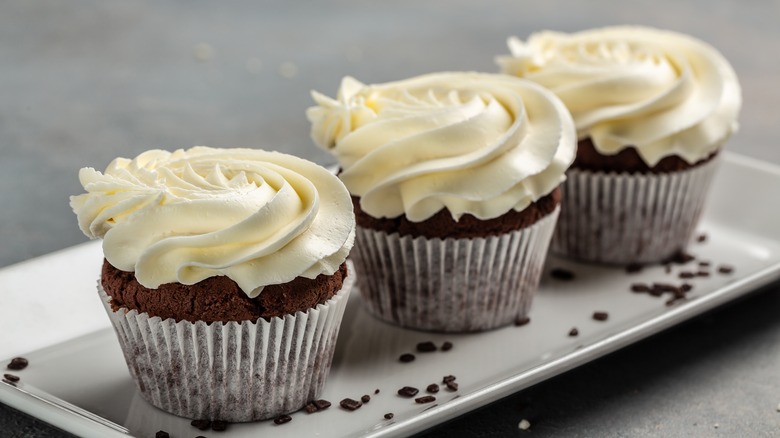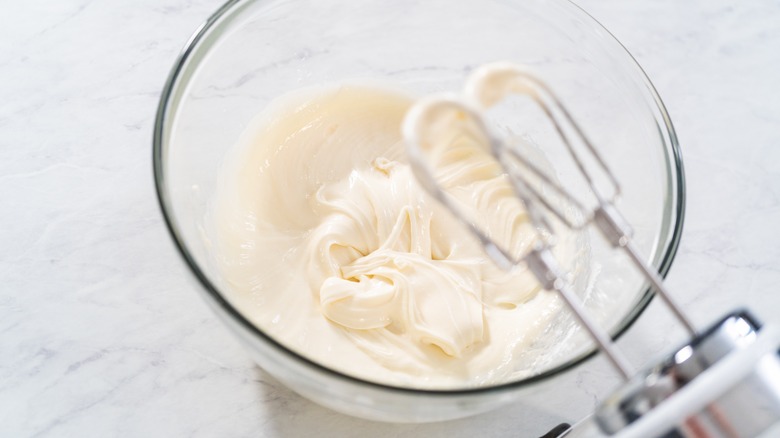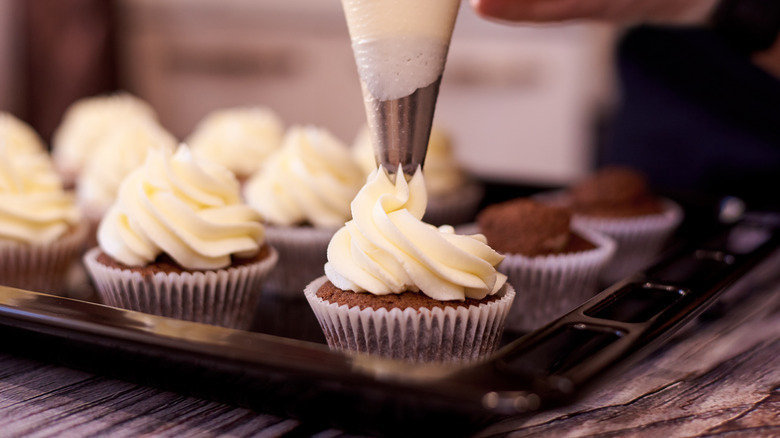Cream Cheese Is Your Secret Weapon For The Best Whipped Cream Frosting
It's hard to deny that whipped cream is one of the most delicious and versatile toppings for any kind of cake or pastry. Not only does a dollop of vanilla whipped cream taste fantastic on just about anything, you can flavor whipped cream with things like caramel or orange blossom to unlock unique flavor combinations. The catch is that it's incredibly flimsy and prone to deflating after a while, making it a poor choice for cake frosting unless you add some sort of stabilizer to the mix. Things like gelatin and cream of tartar may be the first things that come to mind when it comes to adding some much-needed structure to whipped cream — but what you might not know is that cream cheese is your secret weapon for creamy and delicious whipped cream frosting.
You might be thinking that this combination would just make some kind of hybrid between cream cheese frosting and whipped cream frosting, and you'd be right: It's a delightful balance of the best of both worlds. The natural thickness of the cream cheese adds stability to the frosting, making it much more suitable for piping onto cakes and able to hold its shape afterward. It also adds an indulgent creamy texture to the frosting, complementing the slight tang that introduces complexity to the flavor profile. Once you start using the unique taste and texture of whipped cream cheese frosting for your cakes, you may not ever go back to any other kind of frosting at all.
Tips for making whipped cream cheese frosting
The great part about whipped cream cheese frosting is that its uniquely fluffy but rich texture doesn't require any sort of complicated mixing or delicate folding techniques. In fact, it can be made all together in one mixing bowl without even needing to swap out a mixer's whisk attachment. What's even better is that it's a simple five-ingredient mixture: All you need is cream cheese, cold heavy cream, granulated or powdered sugar, some vanilla extract, and a pinch of salt. Make sure you're starting with a block of cream cheese instead of any pre-whipped variety, as well as ensuring you have full heavy cream instead of any substitutes.
While you'll find slight variations across different recipes, the general gist is that you start out by whipping up the softened block of cream cheese in the bowl. You can either add the sugar with the cheese or mix it in after the cheese has been whipped, but either way, you'll want the sugar and cheese to be fully incorporated before you add the heavy cream. The vanilla extract and salt can be added at basically any point between whipping up the cheese and adding in the cream.
The trick to incorporating the whipped cream part of the frosting is to pour the cream slowly while you whip the mixture at high or medium. Just as with making plain whipped cream, you'll want to stop when stiff peaks form in order to avoid overmixing.
How to customize, use, and store whipped cream cheese frosting
While you ideally shouldn't whip it again after it reaches peak consistency, you can add some more cream and whip it for a lighter texture. If you want to thicken it a little more, however, don't reach for extra cream cheese — instead, try refrigerating it for a while before beating it a little more for a firmer texture.
Want to make it with extra flavors? No problem — just add whatever flavored syrup or extract in alongside the vanilla extract. If you're working with something like cocoa powder, make sure to mix it with a bit of heavy cream first to make it easier to incorporate into the mix and avoid a powdery disaster.
Another important thing to keep in mind is that, while whipped cream cheese frosting is more stable than whipped cream, it's a little less stable than cream cheese frosting by the same token. This is definitely the kind of icing you want to keep cold at all times for best results. Whipped cream cheese will be able to hold itself together for about an hour at average room temperature. Otherwise, it'll keep its shape on a cake or cookie for about two to three days in the fridge if needed. Try to keep any leftover frosting in an airtight container — as well as containing any frosted cakes as much as possible — to prevent it from picking up any wayward odors from other fridge items.


